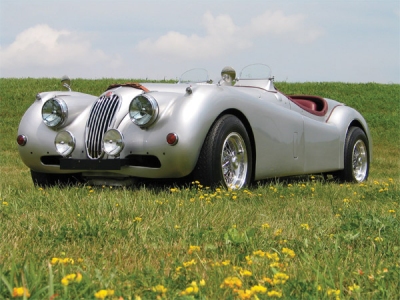SCM Analysis
Detailing
| Years Produced: | 1954-57 |
| Number Produced: | 3,347 roadsters |
| Original List Price: | $3,960 |
| SCM Valuation: | $50,000-$75,000 |
| Tune Up Cost: | $650 |
| Distributor Caps: | $45 |
| Chassis Number Location: | stamped on left-hand chassis side member above rear engine mounting bracket; also stamped on brass plate on firewall |
| Engine Number Location: | stamped on right-hand side of cylinder block above oil filter and front end of cylinder head, adjacent to front spark plug; also stamped on brass plate on firewall |
| Club Info: | Jaguar Clubs of North America, c/o Nelson Rath, 1000 Glenbrook, Anchorage, KY 40223 |
| Website: | http://jcna.com |
| Alternatives: | 1956-63 AC Bristol, 1955-56 Austin-Healey 100M |
| Investment Grade: | B |
This 1956 Jaguar XK 140 sold for $72,600 at RM’s Amelia Island sale, held March 12, 2005.
Jaguar aficionados are a picky lot when it comes to nomenclature. For instance, there is no such thing as a Jaguar convertible. That’s right, one would correctly refer to an “OTS” or “DHC,” for “open two-seater” or “drophead coupe.” An OTS, also referred to as a “roadster,” has removable side curtains instead of windows, and the top folds behind the seats where it is neatly hidden by the rear shroud. A DHC has an attached top that sticks up above the body when folded, roll-up side windows in the doors, and a fancier wood interior, similar to that on the FHC, or fixed-head coupe.
On to the larger semantic point of today’s lesson. Regardless of what the New York motoring press decided to call the optional upgrade package for the XK 140 when it was introduced stateside at the New York Auto Show in 1955, the Jaguar factory literature has always referred to the XK 140 with the optional upgrades as an SE, for “Special Equipment,” and never “MC.” This is also the nomenclature recognized by the Jaguar clubs.
The confusion apparently arose because Jaguar had offered an “M” trim package for U.S.-market XK 120s that added wire wheels, a dual exhaust, and fog lamps. The 140 was available with those upgrades plus the C-type head, so the American press referred to the whole lot as an “MC” package.
Either way you refer to it, the cars had their XK engines upgraded at the factory with a cylinder head of the same design as used on the C-type works cars built for Le Mans. These were painted red, and soon after production began, small badges on the cam covers were added for further identification. The improved engine was good for 210 hp, 20 hp more than the standard XK 140.
The SEs were also equipped with Dayton wire wheels, generally painted in the body color, though chrome ones were also available. Sitting in the showroom, any XK 140 would also have had a set of substantial bumpers, and a proper windshield to provide protection to the driver and passenger, unlike the 1956 Jaguar XK 140 Roadster pictured here.
This particular example, however, has been modified to give it a racy look, bearing more than a passing resemblance to the XK 120 that Phil Hill drove to his first significant victory at the inaugural Pebble Beach road race in 1950.
It’s no surprise then that the seller never drove it in the rain; the aeroscreen modifications don’t provide any place to fasten the soft-top and side screens that should be neatly tucked under the rear cowl behind the seats. This is a limiting factor for this car, as on most of the luxury car tours that are a growing part of the old car hobby, the prospects of getting wet and cold would probably dissuade most from even venturing out on the route. With a proper setup, however, Jaguar roadsters do make ideal long-distance tourers.
Nevertheless, from the $72k sale price-right at the top of the SCM value range of $50k-$75k-we can see that perhaps those in attendance at RM’s Amelia Island sale had more of an affection for racing machinery than weekend tourers. This would be a classic case of finding the right venue in which to sell a particular car to fetch a good price. I would have expected such an older restoration with blemished paint (verified by SCM’s auction reporter) and visually heavy Borrani wheels to have sold closer to the bottom of the price range.
(Historical and descriptive information courtesy of the auction company.)
